
The Golden Gate Biosphere Network is a voluntary coalition of federal, state, and local government agencies, nonprofit organizations, universities, and private partners within the Golden Gate Biosphere region. The Network works towards protecting the biosphere region's biodiversity and conserving its natural resources to maintain the quality of life for people within the region. The Network has been part of the UNESCO Man and Biosphere Programme since 1988 and is part of the US Biosphere Network and EuroMAB. It is recognized by UNESCO due to the significant biodiversity of the region, as well as the Network's efforts to demonstrate and promote a balanced relationship between humans and the biosphere.
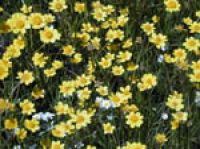
Lasthenia conjugens, commonly known as Contra Costa goldfields, is an endangered species of wildflower endemic to a limited range within the San Francisco Bay Area of the state of California, USA. Specifically this rare species occurs in Napa, Santa Barbara, Solano, Contra Costa, Santa Clara, Monterey and Alameda Counties. This annual herb typically flowers from March through June, and its colonies grow in vernal pool habitats at elevations not exceeding 100 meters above sea level. The Jepson Manual notes that the present distribution is limited to the deltaic Sacramento Valley, principally Napa and Solano Counties, but the historic range of L. conjugens is known to be significantly wider. In any case, historically the range has included parts of the North Coast, Sacramento Valley, and San Francisco Bay Area as well as the South Coast. Alternatively and less frequently this taxon has been referred to as Baeria fremontii var. conjugens.

Hesperolinon congestum, or Marin dwarf flax, is an annual herb, which is known to occur only in San Mateo, San Francisco and Marin County, California, United States. This plant occurs chiefly on serpentine soils, especially in dry native bunch grasses, chaparral or other grasslands at elevations less than 200 meters. The flowers are congested at the tips of the dichotomously branching stems. H. congestum is in flower between April and July. The outlook for this plant depends on survival of only about twenty small colonies, most of which are not actively managed for protection, even though the species is federally and state-listed as threatened. This species is also less commonly known as Marin western flax.
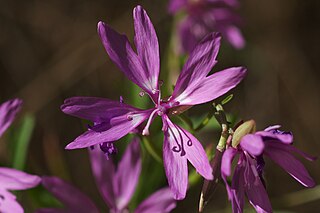
Clarkia biloba is a species of flowering plant in the evening primrose family known by the common name twolobe clarkia and two lobed clarkia.

Clarkia exilis is a small herbaceous annual plant of western North America. It is an uncommon species in the evening primrose family known by the common names Kern River clarkia and slender clarkia.

Clarkia imbricata is a rare species of flowering plant in the evening primrose family known by the common name Vine Hill clarkia. It is endemic to Sonoma County, California, where it is known from only one remaining natural occurrence near Vine Hill. A second natural population located on private land was extirpated when the owners plowed up the soil crust. The California Native Plant Society has established a third population from cuttings and is tending it in a reserve. This is a federally listed endangered species.
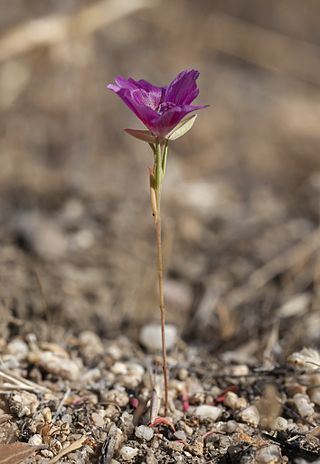
Clarkia jolonensis is an uncommon species of flowering plant in the evening primrose family known by the common name Jolon clarkia. It is endemic to Monterey County, California, where it is known from the woodlands of the Central Coast Ranges.
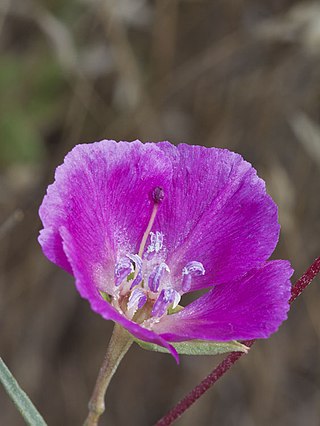
Clarkia speciosa is a species of flowering plant in the evening primrose family known by the common name redspot clarkia. It is endemic to California, where it is known from the Central Coast and mountains and from the Sierra Nevada foothills. The plant is variable across its intergrading subspecies, taking a decumbent to erect form with a stem up to about half a meter long. The open or dense inflorescence has opening flowers and several closed buds. As the bud opens the sepals all separate from each other. The fan-shaped petals are up to 2.5 centimeters long and may be lavender to pink to deep red, sometimes fading to white or yellowish at the base. There is sometimes, but not always, a large bright red spot near the middle of the petal.

Clarkia springvillensis is a rare species of flowering plant in the evening primrose family known by the common name Springville clarkia. It is endemic to central Tulare County, California, where it is known from fewer than 20 occurrences around Springville. It is a federally listed threatened species.
Clarkia tembloriensis is a rare species of flowering plant in the evening primrose family, known by the common name Temblor Range clarkia and belonging to the Onagraceae family.

Clarkia williamsonii is a species of flowering plant endemic to California, where it is known from the forests and woodlands of the northern and central Sierra Nevada foothills.
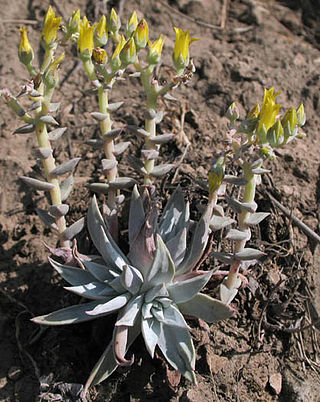
Dudleya verityi is a rare species of succulent plant known by the common name Verity's liveforever. It is endemic to Ventura County, California, where it is known from only three occurrences in the vicinity of Conejo Mountain between Camarillo and Thousand Oaks. It probably occurs in a few additional locations nearby which have not yet been officially vouchered.

Lessingia germanorum is a rare species of flowering plant in the family Asteraceae known by the common name San Francisco lessingia. It is endemic to California, where it is known from four populations in the Presidio of San Francisco and one occurrence on San Bruno Mountain south of San Francisco. It is a state and federally listed endangered species. The already rare plant is endangered by many processes, including invasive species, development, sand mining, off-road vehicles and bulldozers, habitat fragmentation, trampling, and pollution, as well as stochastic events.
Pseudobahia bahiifolia is a rare species of flowering plant in the family Asteraceae known by the common name Hartweg's golden sunburst.

Streptanthus albidus is a species of flowering plant in the mustard family known by the common name Metcalf Canyon jewelflower. It is endemic to California, where it is known only from the Central Coast Ranges and San Francisco Bay Area. It grows in open areas such as grasslands, often on serpentine soils.

Clematis socialis is a rare species of flowering plant in the buttercup family known by the common name Alabama leather flower. It is native to the US states of Alabama and Georgia, where it is known from only five populations. The species is seriously threatened by habitat destruction. It is a federally listed endangered species.
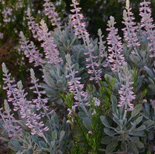
Lupinus aridorum is a rare species of lupine known by the common name scrub lupine. It is endemic to Florida in the United States, where there were 10 known populations remaining in 2003. Fewer than 6000 individual plants were counted. It is threatened by the loss and degradation of its habitat. The scrub lupine is a federally listed endangered species of the United States.

Polygala lewtonii is a rare species of flowering plant in the milkwort family known by the common name Lewton's polygala, or Lewton's milkwort. It is endemic to Florida in the United States, where it is limited to the central ridge of the peninsula. There are about 49 occurrences of the plant remaining. Most occurrences contain very few plants. The species is threatened by the loss and degradation of its habitat. This is a federally listed endangered species of the United States.
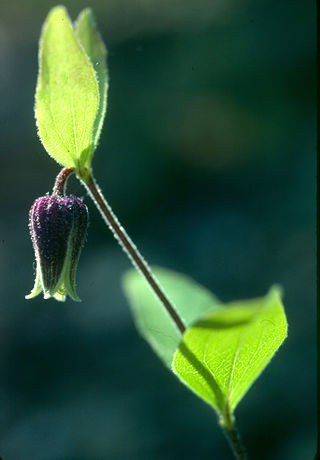
Clematis viticaulis is a species of flowering plant in the buttercup family known by the common names Millboro leatherflower and grape clematis.
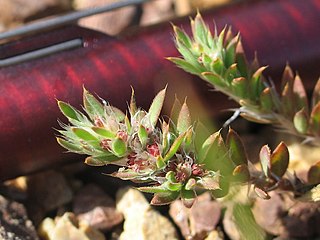
Paronychia franciscana is a species of flowering plant in the family Caryophyllaceae known by the common names San Francisco nailwort, California Whitlow-wort, Franciscan paronychia, and Chilean nailwort. It is native to Chile, but it was first described from specimens collected in San Francisco, California, in the United States, where it is an introduced species.




















